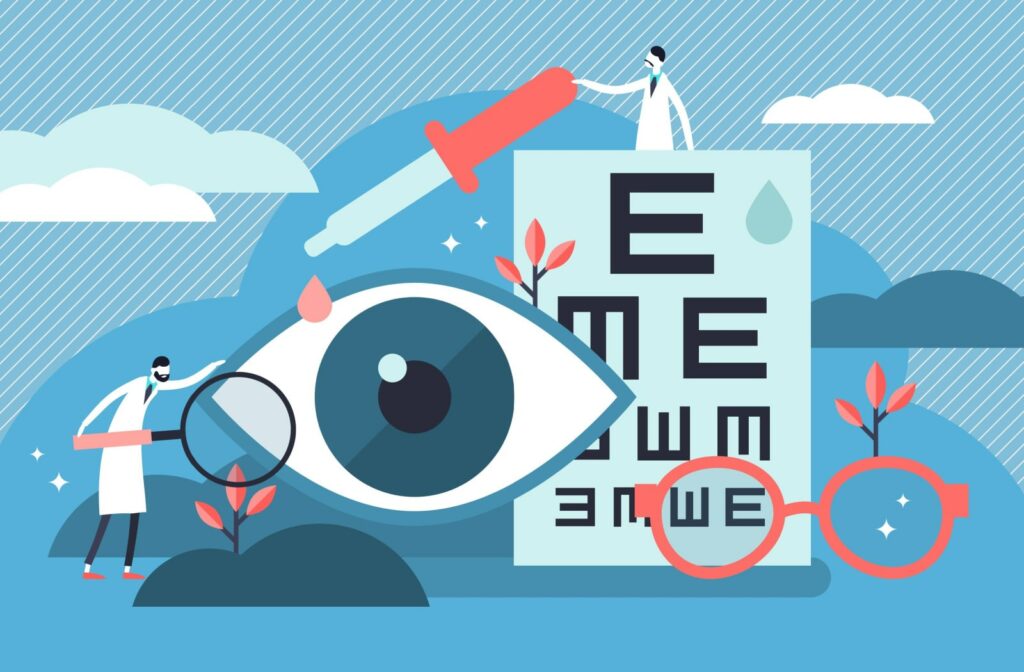Dry eye disease is a common condition that affects millions of Americans. It occurs when the eyes produce fewer tears or your tears evaporate too quickly, leading to burning, itching, redness, and blurred vision.
Chronic dry eye can affect daily life, but you don’t have to bear with the uncomfortable symptoms. Your eye doctor can conduct a comprehensive and dry eye exam to determine a treatment plan that best works for your eyes.
Higgins Brothers’ Vision Care offers several treatments for dry eye, including platelet-rich plasma and autologous serum eye drops. These two eye drops can provide better relief for people with severely dry eyes.
Let’s learn more about dry eye disease and how to treat it.
What Is Dry Eye Disease?
Tears are essential for maintaining the health of your eyes and providing lubrication, moisture, and nutrients to the eye’s surface. When your eyes lack enough tears, or there’s an imbalance in the components that make up your tears, you may develop dry eye disease.
Dry eye disease can cause various symptoms, including:
- Burning or stinging sensation
- Gritty feeling
- Eye redness
- Stringy mucus
- Excessive tearing
- Sensitivity to light
- Blurry vision
- Eye fatigue
- Difficulty wearing contact lenses
Causes of Dry Eye Disease
The causes of dry eye disease can include tear film dysfunction, decreased tear production, or increased tear evaporation. Other causes can include:
- Aging
- Hormonal changes
- Autoimmune disease
- Inflamed eyelid glands
- Allergic eye disease
- Certain medications
- Certain health conditions
- Environmental factors
Diagnosing Dry Eye Disease
A comprehensive eye exam with your optometrist can help diagnose dry eye disease and its severity. Your optometrist may perform various tests depending on the condition. Tests can include:
- The tear break-up time test measures how quickly your tears evaporate.
- The tear osmolarity test measures the water quality in your tear film.
Treatment for Dry Eye Disease
Once the severity of your dry eye is determined, your eye doctor can create a treatment plan for your needs. Treatment for dry eye disease usually involves addressing the underlying cause, providing relief for mild symptoms, or medications for persistent symptoms. These can include:
- Over-the-counter artificial tears
- Prescription eye drops
- Oral medications
- Eye inserts
- Unblocking oil glands
- Punctal plugs
Platelet-Rich Plasma Eye Drops
Platelet-rich plasma (PRP) eye drops are derived from the patient’s own blood. They are rich in growth factors (PRGF) and anti-inflammatory components, offering successful treatment for moderate to severe dry eye.
PRP eye drops offer better relief for patients due to the biological composition of the drops—these drops are more similar to natural tears than artificial tears.
Platelet-rich plasma eye drops also have essential vitamins and cytokines to help recover the damaged corneal and conjunctival epithelium. Left untreated could increase your risk for ocular surface disease (OSD).
Autologous Serum Eye Drops
Autologous serum eye drops (ASEDs), like PRP eye drops, are custom-made from the patient’s blood. They resemble real tears because they contain essential biological nutrients and immunoprotective proteins. In comparison, artificial tears lack the nutrients that tears need to maintain the tear film.
Making ASED involves collecting a small amount of blood from the patient. The serum is then separated from the solid components and diluted with either:
- A balanced salt solution
- Preservative-free normal saline
- Another sterile, preservative-free, eye-compatible solution
Once formulated, the solution goes into a sterile eye dropper bottle. It remains frozen until ready to use and refrigerated while in use.
Because ASED is from a patient’s blood, there is no risk of allergic reactions or adverse effects. Added benefits of ASED can include the following:
- Reduces inflammation
- Promotes overall eye health
- More vitamin A, lysozyme, transforming growth factor‐β (TGF‐β), and fibronectin
Your eye doctor may recommend ASEDs, or PRP eye drops for patients with Sjögren’s syndrome, neuropathic corneal pain, or severe dry eye due to other causes.
Managing Dry Eyes
In addition to these treatments, lifestyle changes can help manage dry eye disease. These can include:
- Avoiding dry environments
- Avoid air blowing in your eyes
- Taking frequent breaks when using a computer or reading
- Blinking regularly to keep your eyes moist
- Add moisture to the air
- Wear wraparound sunglasses or protective eyewear
- Position your computer screen below eye level
- Stop smoking and avoid smoke
- Use artificial tears regularly
Custom-Made Relief for Dry Eye in Plainville
While dry eye disease is a chronic condition, many people can get relief from their symptoms with proper treatment and management. Speak to your eye doctor to determine the best treatment plan for your eye health and vision needs.
If platelet-rich plasma or autologous serum eye drops are a good option for your condition, Dr. Higgins and our knowledgeable team can help! Higgins Brothers’ Vision Care is one of the few optometry practices in New England offering PRP eye drops and ASEDs.
Book an appointment with us today in Plainville.




